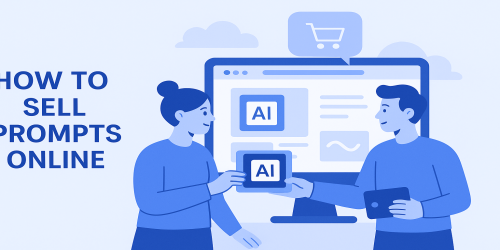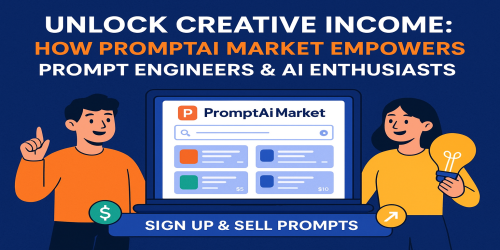
The Rise of AI Prompt Marketplaces: Revolutionizing Creative Tools
This guide is for content creators looking to monetize their prompt skills, businesses seeking ready-made AI solutions, and anyone curious about this emerging digital economy.
We'll explore how major platforms are building the prompt economy and examine the ways creators turn their prompt engineering expertise into steady income streams. You'll also discover how these marketplaces are reshaping traditional creative workflows across industries.
Understanding AI Prompt Marketplaces and Their Core Value

What AI prompt marketplaces are and how they function
AI prompt marketplaces are digital platforms where creators buy and sell pre-written prompts designed to work with various AI tools like ChatGPT, Midjourney, or Stable Diffusion. Think of them as the App Store for AI prompts - centralized hubs where prompt engineers showcase their best work and users discover tested prompts for specific tasks.
These platforms operate on a straightforward model. Prompt creators design and test their prompts across different AI models, then list them with detailed descriptions, examples, and usage instructions. Buyers can browse categories ranging from marketing copy and creative writing to image generation and data analysis. Most marketplaces use tiered pricing structures, with simple prompts starting at a few dollars while complex, multi-step prompt chains command premium prices.
The transaction process mirrors established digital marketplaces. Users preview prompt samples, read reviews from previous buyers, and purchase licenses that typically allow unlimited personal or commercial use. Many platforms also offer subscription models where users pay monthly fees for access to extensive prompt libraries.
Quality control varies across platforms, but leading marketplaces implement rating systems, user feedback mechanisms, and sometimes editorial review processes. Some platforms even provide prompt customization services, where experienced engineers modify existing prompts to match specific user requirements.
Key benefits for creators seeking quality prompts
Creative professionals and content creators gain access to expertly crafted prompts that consistently produce high-quality outputs. Instead of spending hours experimenting with different phrasings and parameters, creators can purchase proven prompts that deliver reliable results across various AI models.
The marketplace model provides creators with extensive variety. Whether you need prompts for generating social media content, creating product descriptions, designing logos, or writing technical documentation, specialized prompts exist for virtually every creative niche. This specialization means prompts are often more effective than generic alternatives because they're built by experts who understand both the AI model's capabilities and the specific industry requirements.
Many marketplaces also offer prompt bundles and collections, giving creators comprehensive toolkits for entire projects. A marketing professional might purchase a bundle containing prompts for ad headlines, social media posts, email campaigns, and landing page copy - all optimized to work together cohesively.
The community aspect adds another layer of value. Users can interact with prompt creators, request modifications, and share success stories. This feedback loop helps creators understand which prompts work best in real-world scenarios and drives continuous improvement in prompt quality.
Time-saving advantages for busy professionals
Time represents the most compelling advantage of prompt marketplaces for working professionals. Developing effective prompts requires understanding AI model behaviors, experimenting with different approaches, and refining language through multiple iterations. This process can consume days or weeks, especially for complex tasks requiring multi-step prompts.
Purchasing proven prompts eliminates this development cycle entirely. A marketing manager can immediately access prompts for campaign planning, content generation, and performance analysis without investing time in prompt engineering. This instant access allows professionals to focus on strategy and execution rather than tool optimization.
The testing and refinement that marketplace prompts undergo also saves professionals from trial-and-error phases. Prompt creators typically test their products across different scenarios and use cases, identifying potential issues and edge cases before listing. This pre-validation means professionals can trust that purchased prompts will work reliably in production environments.
Batch processing capabilities represent another significant time-saver. Many marketplace prompts are designed for high-volume tasks, allowing professionals to process dozens or hundreds of similar requests efficiently. A real estate agent could use specialized prompts to generate property descriptions for an entire listing portfolio in minutes rather than hours.
Cost-effective solutions compared to custom development
The economics of prompt marketplaces strongly favor buyers compared to custom development alternatives. Hiring prompt engineers or AI consultants for custom prompt development typically costs hundreds or thousands of dollars, especially for complex projects requiring specialized knowledge.
Marketplace prompts usually range from $5 to $100, with most falling in the $10-50 range. Even premium prompt collections rarely exceed $200, making them accessible to individual creators and small businesses. This pricing structure allows organizations to access enterprise-level prompt engineering at consumer prices.
The shared development cost model drives these economics. When prompt creators sell to hundreds or thousands of buyers, they can price their work affordably while still earning reasonable returns on their time investment. This distribution effect makes sophisticated prompt engineering economically viable for much smaller organizations than traditional custom development.
Risk mitigation adds another cost advantage. Custom prompt development carries uncertainty - projects might not deliver expected results or require multiple revision cycles. Marketplace prompts come with user reviews, example outputs, and often money-back guarantees, reducing the financial risk associated with prompt investments.
Volume discounts and subscription models provide additional savings for heavy users. Organizations requiring dozens of prompts across different functions often find marketplace subscriptions cost less than developing just a few custom prompts.
Major Players Transforming the Prompt Economy

Leading marketplace platforms and their unique features
PromptBase stands out as the original pioneer in this space, launching in 2022 as the first dedicated marketplace for AI prompts. The platform operates like an app store for prompts, allowing creators to sell their carefully crafted instructions for models like DALL-E, Midjourney, ChatGPT, and Stable Diffusion. What makes PromptBase particularly attractive is its clean interface and quality control system that ensures buyers get working prompts before purchase.
Promptify has carved its niche by focusing heavily on prompt templates and variations. Users can browse through thousands of pre-tested prompts organized by categories like marketing copy, image generation, and coding assistance. The platform's strength lies in its collaborative features, where users can fork and modify existing prompts while crediting original creators.
MajinAI takes a different approach by emphasizing community-driven development. The platform functions more like a social network where prompt engineers share techniques, collaborate on complex projects, and build following around their expertise. Their revenue-sharing model gives creators up to 80% of sales, making it particularly appealing for serious prompt developers.
FlowGPT has gained traction by gamifying the prompt discovery process. Users can upvote effective prompts, creating a natural quality ranking system. The platform also offers prompt collections and themed bundles, making it easier for buyers to find comprehensive solutions for specific use cases.
Specialized niche marketplaces for different creative fields
Creative professionals have sparked the emergence of highly specialized platforms catering to specific industries. ArtPrompts.io focuses exclusively on visual art generation, offering prompts optimized for various artistic styles, from photorealistic portraits to abstract compositions. The platform features detailed preview galleries and style guides, helping artists understand exactly what each prompt produces.
WriteWise targets content creators and copywriters, providing prompts specifically designed for marketing materials, blog posts, social media content, and email campaigns. The platform includes performance metrics showing conversion rates and engagement levels for different prompt styles, giving marketers data-driven insights into what works.
CodePrompt has built a community around programming and technical documentation. Developers can find prompts for code generation, debugging assistance, API documentation, and technical writing. The platform integrates with popular development tools and includes version control features for tracking prompt evolution.
GamePrompts serves the gaming industry with specialized prompts for character creation, world-building, dialogue generation, and game mechanics. The platform partners with indie game developers and larger studios, creating a feedback loop that continuously improves prompt quality.
DesignSeed focuses on UI/UX designers, offering prompts for wireframing, user persona development, design system creation, and accessibility considerations. The platform includes integration with design tools like Figma and Sketch, streamlining the creative workflow.
Enterprise-focused solutions for business applications
Corporate adoption of AI prompt marketplaces has driven the development of enterprise-grade platforms with enhanced security, compliance, and collaboration features. PromptStack Enterprise offers white-label solutions that allow companies to create internal prompt libraries while maintaining full control over intellectual property and data privacy.
BusinessPrompts.ai specializes in professional use cases like financial analysis, legal document review, HR communications, and strategic planning. The platform provides industry-specific prompt collections developed in partnership with domain experts, ensuring outputs meet professional standards and regulatory requirements.
TeamPrompt focuses on collaborative prompt development within organizations. Teams can create shared libraries, establish approval workflows, and track usage analytics across departments. The platform includes role-based permissions and audit trails, meeting enterprise governance requirements.
Corporate clients particularly value these platforms' ability to standardize AI interactions across large organizations. Instead of individual employees creating ad-hoc prompts with inconsistent results, companies can deploy tested, approved prompts that deliver reliable outputs while maintaining brand voice and compliance standards.
Many enterprise platforms also offer custom training and consulting services, helping organizations develop internal prompt engineering capabilities while leveraging marketplace resources for specific needs.
How Creators Monetize Their Prompt Engineering Skills

Building sustainable income streams through prompt sales
The prompt marketplace ecosystem has opened up entirely new revenue streams for creators who understand the art and science of prompt engineering. Successful creators typically start by identifying high-demand niches where their prompts can solve specific problems. For instance, marketing professionals constantly need prompts for social media content, email campaigns, and ad copy, while designers seek prompts for generating logos, illustrations, and mood boards.
Most creators begin by selling individual prompts at prices ranging from $2 to $50, depending on complexity and market demand. The key to building sustainable income lies in volume and consistency. Top sellers often upload 20-50 new prompts monthly across different categories, creating a steady flow of passive income. Smart creators also pay attention to seasonal trends - holiday-themed prompts, back-to-school content, or summer marketing campaigns can generate significant spikes in sales.
Platform analytics play a crucial role in scaling income. Successful prompt engineers track which categories perform best, what pricing strategies work, and which keywords drive the most visibility. Many creators report earning between $500 to $3,000 monthly once they establish a solid catalog of 100+ high-quality prompts across multiple platforms.
Developing premium prompt collections for recurring revenue
Premium collections represent the next evolution in prompt monetization. Rather than selling individual prompts, creators package themed sets that provide comprehensive solutions for specific use cases. A premium collection might include 50 prompts for complete social media campaigns, complete with variations for different platforms, industries, and seasonal adaptations.
These collections typically command higher prices - anywhere from $25 to $200 - because they offer complete solutions rather than individual tools. Creators who master this approach often develop signature styles or specializations that customers recognize and return to. For example, one creator might become known for exceptionally detailed character generation prompts, while another builds a reputation for business strategy prompts that produce actionable insights.
The recurring revenue aspect comes from building customer loyalty and creating prompt series. Successful creators often release monthly or quarterly collections, building anticipation among their customer base. Some establish subscription models where buyers get access to new premium collections as they're released, creating predictable monthly revenue streams.
Creating custom prompts for high-paying clients
The highest earning potential in prompt engineering comes from custom work for businesses and individual clients. Companies increasingly recognize that generic prompts often produce generic results, driving demand for tailored solutions that match their brand voice, industry requirements, and specific objectives.
Custom prompt projects typically range from $100 to $5,000 depending on scope and complexity. A simple custom prompt set for a small business might cost $100-300, while comprehensive prompt strategies for large corporations can command thousands of dollars. These projects often involve detailed consultation calls, multiple rounds of revisions, and ongoing support.
High-value clients include marketing agencies, content creation companies, e-commerce businesses, and creative studios. Many prompt engineers find success by specializing in particular industries - healthcare, finance, or technology - where they can command premium rates due to their specialized knowledge of industry terminology, compliance requirements, and audience preferences.
Building a custom prompt business requires strong communication skills and project management abilities. Successful creators often start by offering custom services at lower rates to build portfolios and testimonials, then gradually increase their rates as demand grows.
Establishing expertise and personal branding opportunities
The prompt marketplace has created unexpected opportunities for personal branding and thought leadership. Successful prompt creators often become recognized experts in AI interaction, building audiences that extend far beyond their prompt sales. This recognition opens doors to consulting opportunities, speaking engagements, and educational content creation.
Many top prompt engineers leverage their marketplace success to build broader businesses. They create YouTube channels teaching prompt engineering, offer online courses, write books about AI interaction, or provide consulting services to businesses looking to integrate AI tools effectively. These additional revenue streams often dwarf their original prompt sales income.
Social media presence becomes crucial for building this expertise brand. Creators share behind-the-scenes content about their prompt development process, showcase impressive results from their prompts, and engage with the broader AI community. Platforms like Twitter, LinkedIn, and Discord have become essential tools for networking and building authority in the space.
The expertise gained from successful prompt engineering also translates into valuable skills for the broader AI economy. Many creators transition into roles as AI trainers, content strategists, or AI implementation consultants, using their deep understanding of how to communicate effectively with AI systems as a competitive advantage in the rapidly evolving job market.
Impact on Traditional Creative Workflows and Industries

Streamlining content creation processes across sectors
AI prompt marketplaces have become the secret weapon for companies looking to speed up their content creation without breaking the bank. Marketing teams that once spent weeks brainstorming campaigns now tap into curated prompts to generate social media content, email sequences, and ad copy in hours. Healthcare organizations use specialized medical writing prompts to create patient education materials, while e-commerce businesses leverage product description templates that convert browsers into buyers.
The transformation goes beyond just speed. Law firms are using legal writing prompts to draft contracts and briefs more consistently, while educational institutions create lesson plans and assessment materials through targeted academic prompts. Tech companies have discovered that well-crafted prompts can generate technical documentation that actually makes sense to both developers and end users.
What makes this shift remarkable is how these prompts maintain quality while dramatically reducing production time. A single prompt template can be adapted across multiple projects, creating a scalable system that grows with business needs.
Democratizing access to professional-quality outputs
Small creative agencies and independent freelancers now compete with major firms thanks to prompt marketplaces. A solo graphic designer can access prompts that generate brand strategies, copywriting frameworks, and visual concepts that rival those produced by large creative teams. This levels the playing field in ways the industry hasn't seen before.
Previously, high-quality creative work required extensive experience, expensive software, and years of skill development. Now, a startup founder with zero design background can use carefully crafted prompts to create professional marketing materials, social media graphics, and even video scripts that look like they came from established agencies.
The democratization extends to specialized fields too. Legal document drafting, financial analysis, and technical writing - once exclusive domains of expensive professionals - become accessible to anyone with the right prompts and basic AI tool knowledge.
Reducing barriers for small businesses and startups
Budget constraints that once forced small businesses to choose between professional marketing and keeping the lights on are becoming less relevant. A local restaurant can now access restaurant-specific prompts for menu descriptions, social media posts, and customer engagement strategies for the price of a few coffees.
Startups particularly benefit from this shift. Instead of hiring full creative teams or expensive consultants, they can invest in prompt collections that cover everything from investor pitch development to user onboarding sequences. This allows them to allocate more resources to product development and customer acquisition.
The ripple effect creates more competition across industries as barriers to entry drop. Small businesses can now present themselves with the same polish and professionalism as established competitors, forcing everyone to step up their game.
Shifting skill requirements in creative professions
Creative professionals are discovering that prompt engineering has become as valuable as traditional creative skills. Copywriters who master prompt creation can sell their expertise repeatedly, while graphic designers who understand AI image generation prompts find themselves in high demand.
The shift creates interesting hybrid roles. Marketing professionals now need to understand both traditional campaign development and prompt optimization. Content creators blend storytelling abilities with technical prompt crafting skills to produce more effective and scalable content.
Rather than replacing creatives, these tools are elevating those who adapt. The most successful professionals combine domain expertise with prompt engineering skills, creating outputs that pure AI or traditional methods alone couldn't achieve. This evolution demands continuous learning but rewards those who embrace the change with expanded opportunities and higher-value work.
Quality Assurance and Trust Building in Prompt Marketplaces

Rating Systems and Community Feedback Mechanisms
Prompt marketplaces rely heavily on transparent rating systems to help buyers make informed decisions. Most platforms use five-star rating scales where users evaluate prompts based on clarity, effectiveness, and value for money. These ratings appear prominently on product listings, creating immediate visual cues about quality.
Community feedback goes beyond simple star ratings. Detailed reviews allow buyers to share specific experiences, including which AI models worked best with particular prompts and what results they achieved. Many platforms encourage users to upload examples of outputs generated from purchased prompts, creating a visual portfolio that demonstrates real-world performance.
Some marketplaces implement sophisticated feedback mechanisms like verified purchase badges, which ensure only actual buyers can leave reviews. This prevents fake reviews and maintains credibility. Advanced platforms also use sentiment analysis to flag potentially biased or suspicious feedback patterns.
The most effective systems create feedback loops between creators and buyers. When issues arise, platforms facilitate communication channels where prompt engineers can address concerns, offer modifications, or provide additional guidance. This collaborative approach builds stronger relationships and improves overall marketplace quality.
Verification Processes for Prompt Effectiveness
Leading prompt marketplaces have developed rigorous testing protocols to verify that prompts actually work as advertised. Before listing, many platforms require creators to submit sample outputs generated using their prompts across multiple AI models like ChatGPT, Claude, or Midjourney.
Automated testing systems run prompts through standardized scenarios to check for consistency and reliability. These systems evaluate factors like response coherence, adherence to instructions, and output quality across different input variations. Prompts that fail these tests get flagged for revision or rejection.
Human verification adds another layer of quality control. Expert reviewers with deep AI knowledge test prompts manually, checking for edge cases that automated systems might miss. They also verify that prompts actually produce the claimed results and don't contain misleading descriptions.
Version control plays a key role in maintaining prompt effectiveness. When AI models update, previously working prompts might break or perform differently. Top marketplaces track these changes and require creators to update their prompts accordingly, ensuring buyers always receive functional products.
Refund Policies and Buyer Protection Measures
Robust refund policies protect buyers from ineffective or misleading prompts. Most reputable marketplaces offer 30-day money-back guarantees if prompts fail to work as described. This policy covers cases where prompts produce completely different outputs than advertised or don't function with specified AI models.
Buyer protection extends beyond basic refunds. Platforms maintain escrow systems that hold payments until buyers confirm satisfaction with their purchases. This approach protects both parties - creators get paid for quality work, while buyers receive guaranteed value.
Dispute resolution mechanisms handle conflicts between buyers and sellers. Professional mediation teams review evidence from both sides, including chat logs, prompt files, and generated outputs. These teams make binding decisions about refunds or required improvements.
Some platforms go further with satisfaction guarantees. If a prompt doesn't meet expectations, they offer credits for future purchases or connect buyers with alternative creators who can provide better solutions. This comprehensive protection builds buyer confidence and encourages more transactions within the marketplace ecosystem.
Smart platforms also implement fraud detection systems that identify suspicious patterns like mass refund requests or coordinated negative reviews, protecting legitimate creators from bad actors.
Future Growth Opportunities and Market Evolution

Integration with emerging AI technologies and platforms
AI prompt marketplaces are on the cusp of major technological breakthroughs that will reshape how we interact with artificial intelligence. The integration of multimodal AI systems represents one of the most exciting frontiers. Soon, prompts won't just generate text or images separately – they'll orchestrate complex workflows that combine video, audio, 3D models, and interactive elements in a single creative process.
Voice-activated prompt engineering is already showing promise, allowing creators to develop prompts through natural speech patterns rather than typed instructions. This opens doors for accessibility and makes prompt creation more intuitive. Imagine describing your vision out loud and having the marketplace automatically generate, test, and refine the corresponding prompts.
Real-time collaboration features are emerging where multiple users can contribute to prompt development simultaneously. These platforms use AI to merge different creative approaches, suggesting optimal combinations and highlighting potential conflicts before they become issues.
The integration with no-code platforms is particularly game-changing. Creators can now build entire applications powered by their prompts without writing a single line of code. This democratizes app development and creates new revenue streams for prompt engineers.
Cross-platform compatibility is becoming standard, with prompts designed to work seamlessly across different AI models. This reduces vendor lock-in and gives creators more flexibility in how they deploy their intellectual property.
Expansion into new creative domains and use cases
The reach of AI prompt marketplaces extends far beyond traditional text and image generation. Scientific research is becoming a major growth area, with specialized prompts helping researchers analyze data, generate hypotheses, and even write grant proposals. Academic institutions are creating internal marketplaces where faculty can share domain-specific prompts for everything from literature reviews to statistical analysis.
Legal professionals are discovering the power of carefully crafted prompts for contract analysis, legal research, and document drafting. Law firms are building proprietary prompt libraries while also contributing to specialized legal marketplaces that ensure compliance and accuracy.
Healthcare applications are emerging cautiously but steadily. Medical prompt marketplaces focus on administrative tasks, patient education materials, and research support while maintaining strict compliance with privacy regulations. These platforms often include specialized validation processes and require medical professional oversight.
The entertainment industry is embracing prompt marketplaces for game development, where prompts generate everything from character backstories to entire virtual worlds. Music producers use prompts to create lyrics, generate beats, and even compose full orchestral arrangements.
Educational technology represents another massive opportunity. Teachers are creating and sharing prompts that generate personalized learning materials, quiz questions, and interactive lessons. These educational prompt marketplaces often include age-appropriate filters and curriculum alignment features.
Development of collaborative prompt creation tools
The evolution from individual prompt creation to collaborative development is transforming how creative communities work together. Version control systems specifically designed for prompts allow teams to track changes, merge improvements, and maintain multiple prompt variations simultaneously. This brings software development practices to creative workflows in ways that feel natural and intuitive.
Community feedback loops are becoming more sophisticated, with rating systems that go beyond simple star ratings. Users can now provide specific feedback on prompt accuracy, creativity, consistency, and ease of use. This granular feedback helps prompt creators understand exactly where improvements are needed.
Crowd-sourced prompt testing is gaining momentum, where marketplace communities collectively test new prompts across different scenarios and edge cases. This distributed testing approach catches issues that individual creators might miss and ensures prompts work reliably across diverse use cases.
Prompt forking and remixing features allow creators to build upon each other's work legally and transparently. The original creator gets attribution and potentially compensation while the derivative work adds new value. This creates an ecosystem where ideas evolve and improve through collaborative iteration.
AI-assisted collaboration tools are emerging that can suggest improvements to existing prompts, identify potential conflicts when multiple prompts are combined, and even propose new prompt ideas based on market demand and creator expertise. These tools don't replace human creativity but amplify it by handling routine optimization tasks.

AI prompt marketplaces have emerged as game-changers in the creative world, offering a new way for skilled prompt engineers to turn their expertise into income while helping businesses and creators access high-quality prompts instantly. These platforms are reshaping how we think about creative collaboration, making specialized AI knowledge more accessible and creating fresh revenue streams for digital creators. The major platforms leading this space have built robust systems for quality control and trust, proving that prompt engineering is a legitimate skill worth paying for.
The creative landscape is evolving rapidly, and those who embrace these marketplaces early will likely see the biggest rewards. Whether you're a seasoned prompt engineer looking to monetize your skills or a business seeking reliable AI prompts, now is the perfect time to explore what these platforms offer. The prompt economy is just getting started, and the opportunities for both creators and users will only continue to grow as AI becomes more integrated into our daily workflows.








